Understanding Birdcages & Stands: A Guide for Enthusiasts
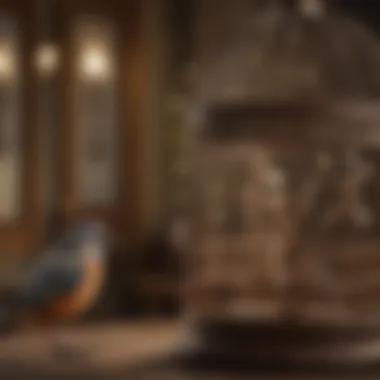
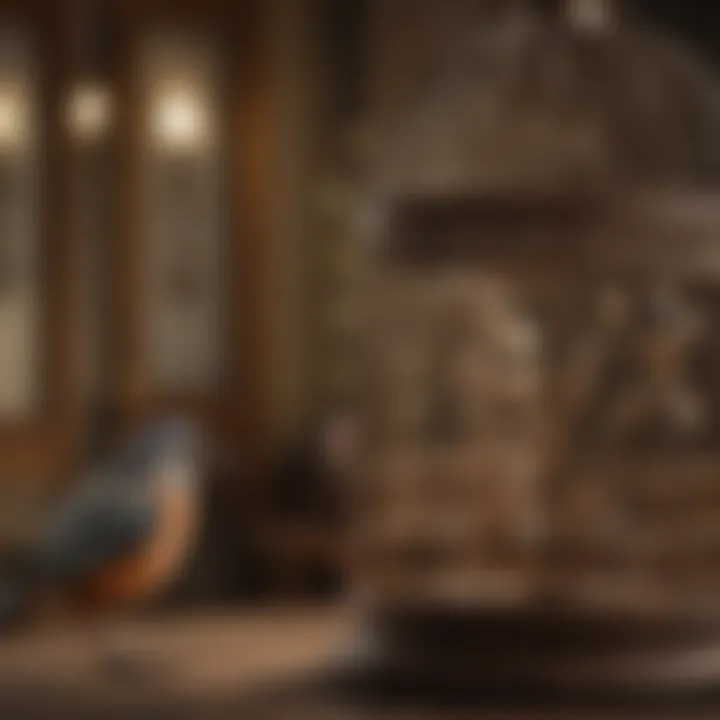
Intro
Birds are charming companions, and providing them with a suitable living environment is crucial for their wellbeing. Birdcages serve as the primary habitat for these pets. They are not just functional; their design and quality significantly affect the health and happiness of birds. Furthermore, stands enhance the versatility of a bird’s living space, allowing for safe exploration outside of their cages. Knowing how to properly care for these elements can greatly improve the bond between avian companions and their owners.
Throughout this guide, we will cover the essentials of birdcages and stands. We will examine key designs and materials, care routines, and maintenance practices. Our aim is to equip both new and experienced bird owners with the knowledge to create a nurturing environment for their feathered friends.
Care Tips
Daily Care Routines
Establishing a daily care routine is imperative for your birds. This includes feeding, providing fresh water, and ensuring the environment is safe and stimulating. Observing your bird during these times can give insights into their behavior and needs. Regular interaction is essential. It fosters trust and can help identify any concerns early.
Cage Setup and Maintenance
When setting up a cage, consider the size, ventilation, and bar spacing. It is important that birds have enough space to spread their wings and move comfortably. A well-positioned cage that is kept clean plays a vital role in your birds’ overall health. Regularly check for loose parts and sharp edges.
Hygiene and Cleaning Practices
Maintaining cleanliness is critical. Birdcages should be thoroughly cleaned at least once a week. Remove waste and remnants of food daily. Use bird-safe cleaners. This prevents the buildup of bacteria and promotes a healthier living space.
Seasonal Care Adjustments
Different seasons affect bird care needs. In summer, ensure adequate ventilation and prevent overheating. Conversely, during winter, make adjustments to keep your birds warm without compromising ventilation. Changes in light exposure also impact birds' behavior and breeding cycles.
Behavioral Insights
Understanding Bird Body Language
Birds communicate through body language. Recognizing signs of comfort or stress is essential for bonding. A relaxed bird will preen and chirp. Meanwhile, a puffed-up bird might be feeling threatened or cold.
Common Behavioral Issues and Solutions
Some common concerns include excessive screeching or feather plucking. Addressing these issues early is key. Providing enrichment and engaging mental activities often resolves behavioral problems. Observing interactions with other pets or humans can also help to identify stressors.
Positive Reinforcement Techniques
Using treats and praise can encourage good behavior. Timing is crucial for reinforcement to be effective. Consistent responses to their behavior promote learning.
Social Interaction Needs
Birds are social creatures; they often thrive on interaction. Consider the companionship of another bird or spending more time with them. Social needs must be balanced with their independence to create a harmonious environment.
Nutrition Guides
Essential Diet Components
A balanced diet is fundamental for any pet bird. Seeds, pellets, fruits, and vegetables should be part of their diet. Different species have unique nutritional needs.
Safe and Toxic Foods
It is critical to know which foods are safe. For instance, apples are safe, whereas avocados can be toxic. Always research before introducing new foods.
Supplements and Treats
Occasionally, supplements can enhance a bird's health. Consult your vet about necessary vitamins or minerals. Treats can be used to strengthen your bond during training sessions.
Feeding Strategies for Different Species
Recognizing the dietary needs based on species is important. Parrots may require more varied diets than other birds. Always ensure your diet meets the specific needs of your bird’s breed.
Wellness and Health
Routine Health Checkups
Regular checkups with a veterinarian are vital. Schedule these visits annually or as needed. Early detection of issues can prevent serious health problems.
Identifying Symptoms of Illness
Familiarizing yourself with common symptoms of illness helps in quick response. Signs may include lethargy, changes in appetite, or altered droppings.
Preventative Care and Vaccinations
Vaccinations and preventative care should be part of your health plan. Discuss these aspects with your vet to ensure your birds remain healthy and vigorous.
Mental and Emotional Well-being
Mental stimulation is equally important. Providing toys, social interaction, and safe exploration can enhance their emotional health.
Enriching Activities
Toys and Playtime Ideas
Invest in various toys to keep your bird engaged and active. Rotate toys to maintain interest. Playtime outside the cage under supervision is essential for exercise.
Training and Tricks
Training provides mental stimulation and a great bonding experience. Start with simple commands and gradually increase the difficulty.
Outdoor Activities and Interaction
Allowing supervised outdoor time can be beneficial. Fresh air and sunshine can enhance mood but always ensure safety.
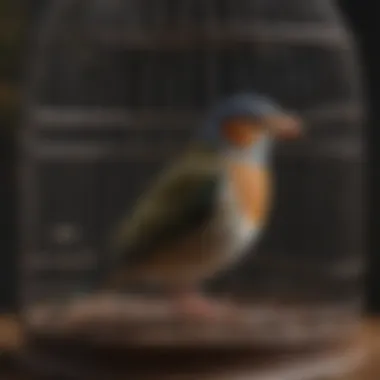
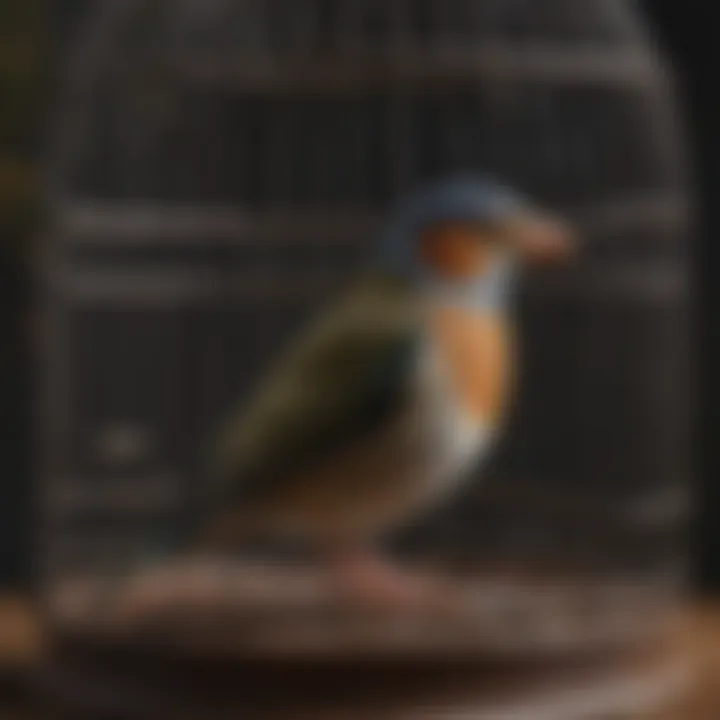
DIY Projects for Mental Stimulation
Creating DIY toys or enrichment activities can be a rewarding experience. Simple projects can often stimulate a bird’s curiosity and engage their instincts.
Creating enriching environments for your birds is a continuous process. Regular adjustments based on observed behavior and health can significantly enhance their quality of life.
This guide will provide you with insights and practical applications to elevate your bird-keeping experience. A well-cared-for pet bird is a happy pet, and your dedication to understanding their needs is the foundation for a lasting relationship.
Preface to Birdcages
Birdcages serve as essential living spaces for pet birds. Their design and functionality play a crucial role in the wellbeing of these creatures. An understanding of birdcages is important for anyone who considers becoming a bird owner or already is one. This section will delve into the purposes of birdcages as well as their historical significance. By examining these aspects, one can grasp the complexities involved in bird care and appreciate the deeper ties between birds and their habitats.
Purpose of Birdcages
The central purpose of a birdcage is to provide a safe environment for pet birds. This containment is vital for their protection from predators and unsafe environments. Birdcages also allow owners to have control over their pet's daily interactions and routines.
Additionally, a properly designed birdcage can improve the overall quality of life for birds. This includes ample space for movement, perching, and exploration. It is not just about security but fostering an enriching environment that supports the bird's instincts. A well-structured cage promotes good health and positive behavior in pet birds.
Historical Perspective
Birdcages have a long history that dates back centuries. Initially, they were made for capturing wild birds for amusement or companionship. Many cultures used cages to showcase exotic birds, reflecting social status or artistic taste.
As time passed, the focus shifted toward the care aspect of these enclosures. The modern birdcage began to evolve, emphasizing the bird’s health and comfort. Today, with increased knowledge about avian needs, owners recognize that a good birdcage is much more than a simple container. It is a critical part of an enriched life for pet birds. They deserve thoughtful design and consideration, which this article aims to elaborate on further.
Choosing the Right Cage
Selecting the appropriate birdcage is critical for the health and happiness of pet birds. The cage serves not only as a shelter but also as a space for exploration and activity. A well-chosen cage impacts a bird's physical wellbeing and behavioral health. Confining a bird to an inadequate cage can lead to stress and health issues.
When considering the right cage, factors like size, material, and design features come into play. Each aspect influences how the bird will live and interact with its environment. Therefore, taking a methodical approach can ensure that both the birds and their owners benefit.
Size and Space Requirements
Understanding the size and space needs of your bird is paramount. Birds require space to roam, stretch their wings, and engage in natural behaviors. The general guideline is to choose a cage that is at least twice the wingspan of the bird. This rule applies to both height and width.
Birds like parrots typically prefer larger cages, allowing for various perches and toys. A cramped cage can lead to poor mental health and physical problems. It is essential to consider the size of the bird when selecting a cage. For instance, smaller birds may thrive in cages as small as 30 inches, while larger species need cages that can be several feet wide.
Materials and Construction
The material of a birdcage influences durability and safety. Common materials include metal, plastic, and wood. Each has distinct characteristics and offers different advantages and drawbacks.
Metal
Metal cages are often favored for their strength. Stainless steel is the most prevalent type; it is durable and resistant to rust. The key characteristic of metal cages is their longevity. They can withstand the wear and tear of daily life. Metal cages also offer a degree of security against escape attempts by clever birds. However, this material can become cold, which might not be comfortable for certain birds.
Advantages include easy cleaning and resistance to feather damage. Disadvantages are that some birds may chew through softer metals, leading to safety issues.
Plastic
Plastic cages tend to be lightweight and easy to move. They are often available in vibrant colors and can appeal to both birds and owners. The significant characteristic of plastic is its lightweight nature. This can encourage portability. Additionally, plastic can be molded into various shapes, offering unique designs unlike traditional cages.
However, plastic tends to be less durable than metal. In heavy-use scenarios, it may crack or bend. Regular cleaning can also be a challenge as certain plastics may hold onto odors.
Wood
Wooden cages can provide a natural feel for birds, connecting them to their environment. The key characteristic of wood is its aesthetic appeal. Many people appreciate wooden cages for their design. The unique feature of wooden cages is their ability to blend into home decor while giving a sense of nature to the housed birds.
Despite the appeal, wooden cages may suffer from wear and tear as they can absorb moisture or bird droppings. This requires more preventive maintenance to keep them in good condition.
Bar Spacing Considerations
Bar spacing is an important aspect of cage safety. The distance between bars should be appropriate for the bird's size. Bars that are too far apart can allow small birds to escape or get stuck. For larger birds, bars must be closer together to prevent injury from attempting to squeeze through.
As a rule of thumb: 1/2 to 5/8 inches is suitable for small to medium-sized birds, while larger birds will need spacing around 3/4 to 1 inch.
By understanding these factors, bird owners can make informed decisions that will optimize their pet's environment.
Design Features of Birdcages
Design features play a crucial role in the functionality and attractiveness of birdcages. Each element must reflect the needs of the bird and the aesthetic preferences of the owner. The right design not only enhances the overall environment for avian pets but also simplifies the responsibilities of maintenance and care. Important considerations include shape, layout, ventilation, light, and accessibility.
Shape and Layout
Rectangular vs. Round
In the context of avian housing, the choice between rectangular and round birdcages greatly impacts the bird's habitat. Rectangular cages offer a more practical layout as they usually provide more horizontal space, which is preferable for birds that enjoy moving around. The design allows for effective use of space, making it easier to fit in various accessories like perches and toys.
On the other hand, round cages can be visually appealing, creating a sense of openness. However, their shape may restrict the space available for bird activities. Many birds feel more comfortable in a rectangular cage where the corners provide a sense of security. Thus, rectangular cages tend to be more beneficial for avian care as they cater to both movement and comfort.
Vertical vs. Horizontal Space
Analyzing vertical versus horizontal space is essential for birdcage design. Birds require ample room to fly and extend their wings. Vertical cages optimize upward space, which is particularly beneficial for climbing species like parakeets or cockatiels. This design encourages natural behavior by allowing birds to explore different levels, replicating their instinctual environments.
Conversely, horizontal cages may not allow as much vertical exploration but provide more room for social interactions and activities on a single level. The choice may depend on the specific species one is caring for. Most importantly, understanding the natural behavior of the bird will aid in selecting the proper space configuration.
Ventilation and Light
Good ventilation and adequate natural light are both necessary for bird health and wellbeing. Proper airflow helps prevent the buildup of harmful gases and keeps the environment refreshing. Adequate exposure to direct sunlight supports a bird's physiological functions and overall mood.
Bird owners should ensure that cages are designed with multiple openings or mesh material that promotes airflow while still keeping the bird secure. Also, acclimating birds to natural light is vital. This can be achieved by placing the cage in a well-lit area of the home while considering drafts and temperature fluctuations.
Accessibility Factors
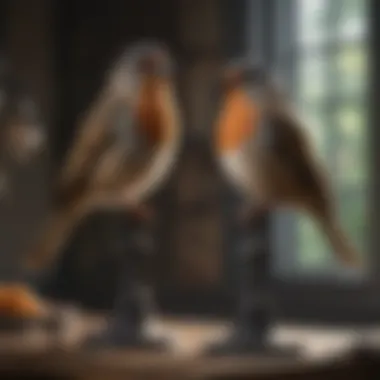
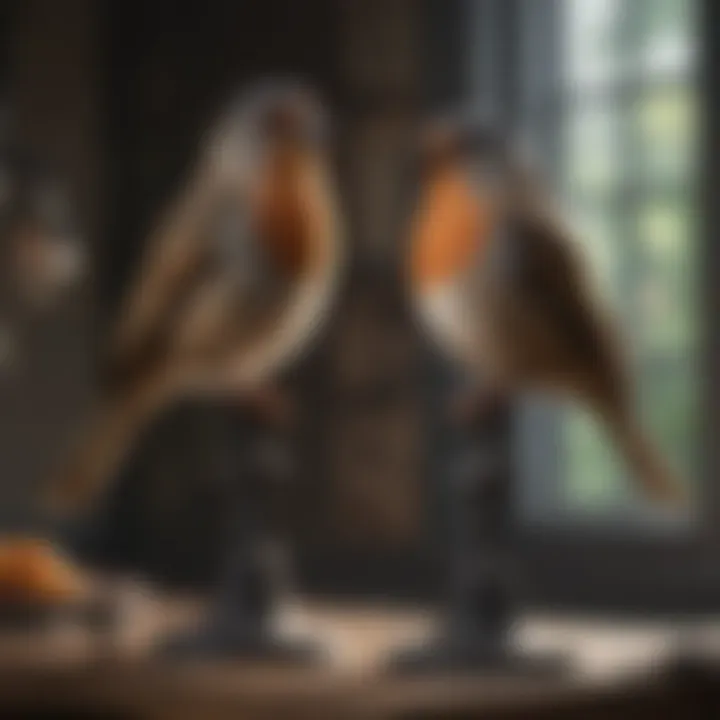
Feeding Access
Feeding access refers to how easily food can be placed in the cage without causing distress to the bird. This is an important design feature as it directly affects the daily management of the bird's diet. Cages with well-placed feeding doors or removable food containers make this task easier, thereby ensuring that owners can feed their avian pets regularly.
It's beneficial for cages to have bowls that can be accessed from outside. Such access minimizes the disturbance to the bird and ensures a consistent feeding routine. Additionally, the design should consider preventing spillage and maximizing hygiene.
Cleaning Access
Cleaning access is paramount in maintaining an optimal living environment for birds. Cages designed with easy-to-remove trays and compartments simplify the maintenance process, making it easier to conduct routine cleaning.
Efficient cleaning access reduces the amount of time spent on upkeep and can ultimately lead to a healthier living conditions for the birds. Cages should include features such as slide-out trays or large entry points that allow for quick access to all areas of the cage. By enhancing ease of cleaning, bird owners devote more time to interacting with and caring for their pets.
Bird Stand Varieties
Bird stands are essential features in the context of avian care, as they provide additional space for birds to relax and socialize outside their cages. They promote physical and mental well-being, offering essential enrichment that stimulates natural behaviors. Understanding the various types of bird stands can help owners make informed choices that cater to the specific needs of their feathered companions.
Types of Bird Stands
Perch Stands
Perch stands are a common type of bird stand, primarily designed for resting or relaxing. They typically consist of a horizontal bar where birds can comfortably perch.
A key characteristic of perch stands is their simplicity. They take up less space compared to other stand types, making them a beneficial choice for smaller living areas. The unique feature of many perch stands is the adjustable height, allowing owners to modify them based on their birds' preferences and behavior.
Advantages of Perch Stands:
- Space-efficient and often portable
- Encourages natural perching behavior
- Easy to clean and maintain
One disadvantage is that perch stands may not offer as much stimulation as more complex structures. They serve their purpose well but lack the interactive features some other stands provide.
Play Stands
Play stands are designed for interactive play. They often come with multiple levels, swings, ramps, and toys to engage birds in active exploration.
The key characteristic of play stands is their versatility. They provide various activities that promote mental stimulation, exercise, and social interaction. The unique feature of play stands is their design, which aims to mimic natural foraging environments, encouraging birds to explore and engage more thoroughly.
Advantages of Play Stands:
- Increases physical activity
- Fosters mental engagement through play
- Provides variety in routine, preventing boredom
However, play stands can require more space and regular setup time. They can be overwhelming for some birds, especially if not gradually introduced.
Travel Stands
Travel stands cater to mobility, allowing owners to transport their birds safely outside of their usual environment.
A key characteristic of travel stands is their lightweight design. Many travel stands are collapsible, making them easy to pack and carry. The unique feature includes safety mechanisms that secure birds during travel, providing assurance of their safety in transit.
Advantages of Travel Stands:
- Convenient for trips and outings
- Lightweight and portable
- Provides familiarity of surroundings while being away from home
The downside to travel stands is they may not offer the same stability as stationary stands. Also, they often have limited space for growth or additional activities.
Material Selection for Stands
Choosing the right materials for bird stands is crucial for ensuring durability, safety, and ease of maintenance. Common materials include wood, metal, and plastic.
- Wood:
- Metal:
- Plastic:
- Natural appearance and texture, appealing to birds.
- Offers good grip, but must be treated to avoid splintering.
- Strong and long-lasting.
- Should be coated with non-toxic finishes to prevent rust or toxins.
- Lightweight and easy to clean.
- Can be less appealing to birds compared to natural materials.
When selecting materials, consider the potential for wear and tear, safety, and interactions with your bird's habits. Proper material selection can significantly enhance the overall experience for both birds and their caretakers.
Importance of Stands
Bird stands play a critical role in the overall wellbeing of pet birds. Their significance extends beyond just a simple platform for birds to perch on. Stands provide various benefits that enhance the living environment and interaction between birds and their owners. The right stand can create an inviting space where birds can exercise, socialize, and stimulate their minds effectively.
One key aspect of using bird stands is their ability to provide enrichment. Birds are inherently active creatures that require mental stimulation and physical activity. Without sufficient room to move about, they can develop stress or engage in undesirable behaviors. A well-designed bird stand can offer an alternative space where a bird can explore, climb, and play safely. Different stands come with various features such as multiple perches, toys, and even ladders which can encourage exploration and movement.
Another important element is the ease of interaction that bird stands facilitate. Pet owners usually want to build a connection with their birds. Having a stand nearby allows for closer interaction during training or simply spending quality time. Birds can feel more comfortable on a stand away from their cage. This separation can make them feel secure while allowing owners to engage them without barriers.
Providing a variety of stands also caters to individual bird species. Different birds have different needs. A stand that works well for a budgie might not suit a cockatoo or macaw. Therefore, selecting the appropriate type of stand is crucial. Additionally, stands can be used in various locations within a home, creating a more dynamic environment that adapts to both the bird's requirements and the owner's lifestyle.
"Stands are not merely furniture for birds. They are vital for enrichment and interaction."
In summary, the importance of stands goes beyond simple aesthetics. They are crucial tools for promoting avian health and happiness. By understanding their benefits, bird owners can create a nurturing environment that supports both physical activity and social interaction.
Maintenance and Care
Maintaining and caring for birdcages and stands is crucial for the health and wellbeing of pet birds. Proper upkeep ensures that the environment where birds live, play, and interact is safe and hygienic. Regular maintenance can prevent disease, accidents, and overall stress for the birds.
Birds are sensitive creatures. They thrive in environments that are clean and free from harmful substances. Unattended cages can quickly become a breeding ground for bacteria and parasites. These pathogens can lead to serious health issues. Hence, a routine maintenance schedule is essential for every bird owner.
Cleaning Protocols
Establishing effective cleaning routines is a fundamental aspect of birdcage maintenance. Clean cages contribute to the health of your pet birds while also promoting a pleasant atmosphere in your living space.
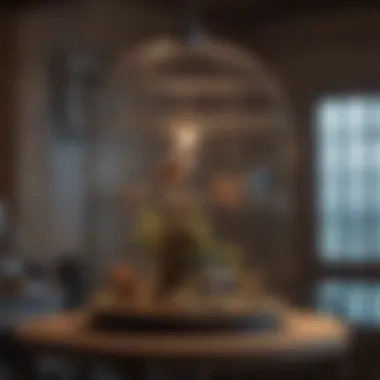

- Daily Cleaning Tasks:
- Weekly Cleaning Tasks:
- Monthly Tasks:
- Remove Food and Water: Empty bowls need to be cleaned and refilled every day. This prevents stale food and contaminated water which can harm the birds.
- Spot Clean: Remove any droppings or leftover food immediately. This practice reduces odors and keeps the cage more hygienic.
- Complete Cage Cleaning: Once a week, it is important to thoroughly clean the entire cage. Use a mild soap solution or bird-safe cleaners to wipe down all surfaces. Rinse thoroughly to ensure no residue remains.
- Sanitize Toys and Accessories: All items within the cage should be cleaned and disinfected to minimize the risk of bacterial growth.
- Deep Cleaning: This involves removing all accessories and doing a more thorough scrub of the cage structure. It’s also a good time to evaluate the state of the cage and its accessories.
"An unkempt cage not only affects a bird's health but can also impact its behavior and mood. Regular upkeep can promote better mental stimulation and comfort, making cleaning a priority for avian welfare."
Checking for Wear and Tear
Assessing the birdcage and stand for signs of wear and tear is essential in maintaining a safe environment for your birds. Both materials and structure can deteriorate over time due to daily use and exposure to droppings or food.
- Inspect Regularly:
- Replacement Parts:
- Immediate Action:
- Check for rust on metal cages, splinters on wooden surfaces, and cracks in plastic components. Any form of damage can lead to injury for your pet.
- Look for loose parts or any instability in the stand. Birds can be active and may accidentally topple a stand that is not secure.
- Understand which components are replaceable. For example, perches can be swapped out when they become worn, while some cages may require entire sections to be replaced.
- If any damage is observed, act quickly. Depending on the severity, repairs may be enough, or it might be necessary to replace the entire cage or stand.
- Keeping various spare parts handy can make repairs quick and more efficient.
In summary, maintenance and care are not just tasks; they are commitments that ensure the health and happiness of your avian companions. Regular cleaning and careful monitoring of wear and tear will help maintain a healthy, secure, and enriching environment for your birds.
Safety Considerations
Safety considerations are critical in ensuring that birdcages and stands provide a secure living environment for pet birds. These elements not only contribute to the overall health of the birds but also enhance the trust and bond between the birds and their owners. It is essential to be aware of potential risks associated with materials, design, and placement of cages and stands.
Toxic Materials
When selecting a birdcage or stand, understanding the materials used is essential to avoid harmful substances. Many materials can pose risks to birds. Some examples of toxic materials include:
- Lead: Often found in paint or soldered joints in older cages.
- Zinc: Commonly used in galvanized wire, it can cause respiratory issues or death if ingested.
- Non-stick coatings: Products with Teflon can release fumes that are lethal to birds when overheated.
- Certain plastics: Some plastics contain chemicals that may leach into the environment when chewed.
It is vital to choose cages and stands that are made from bird-safe materials. Look for items labeled as non-toxic and specifically designed for avian use. Regular inspection for wear can also help identify any potential hazards arising from these materials.
Preventing Escape
Another prominent safety concern is preventing birds from escaping their cages or stands. Birds have a natural instinct to explore, and even the smallest opening can become a point of escape. Proper security measures include:
- Secure Locks: Ensure that doors have secure locking mechanisms. Simple latch closures may not be sufficient for more intelligent or determined species.
- No Gaps: Check for gaps between bars that are larger than the bird's head. A rule of thumb is that the spacing should suit the species of bird you own.
- Heavy Base: For freestanding bird stands, a sturdy base is crucial to prevent tipping during play or exploration.
- Supervised Out-of-Cage Time: If letting birds out of their cages, supervision is imperative. Close windows and doors to prevent accidental escapes.
"Safety is not just about preventing accidents; it is about creating an environment where birds can thrive without unnecessary risks."
By addressing these two safety considerations, pet bird owners can ensure a more secure environment for their feathered companions. Such attention to detail not only enhances the quality of life for birds but also fosters a responsible pet ownership experience.
Creating an Enriching Environment
Creating an enriching environment for pet birds is crucial for their physical and mental wellbeing. Birds, being intelligent and social creatures, require more than just a cage that provides safety. They need an atmosphere that encourages natural behaviors and offers stimulation. This section discusses important aspects like decor, accessories, and placement of cages and stands. By considering these elements, bird owners can enhance their pets' quality of life significantly.
Decor and Accessories
Decor and accessories play a vital role in any bird’s habitat. They provide not only aesthetic value but also functional aspects that mimic natural settings.
- Perches: Different types of perches, such as natural branches or manufactured ones with varied diameters, keep the bird’s feet healthy by preventing sores.
- Toys: Engaging toys help stimulate birds mentally. They can encourage play, exploration, and exercise, reducing stress and boredom.
- Hiding Places: Some birds prefer an area for privacy. Providing small hides or covered spots can create a safe space for them.
When selecting decor, it is crucial to ensure that all materials are safe and non-toxic. Avoid anything with sharp edges or small detachable parts that could be choking hazards. Furthermore, regularly rotating toys and accessories can keep the environment fresh and interesting for your bird.
Placement of Cage and Stand
The placement of both the cage and any stands is essential in creating a nurturing atmosphere for birds. Thoughtful positioning can impact the bird’s comfort and overall interaction with its surroundings.
Lighting Considerations
Lighting plays a significant role in a bird’s life. Natural light is ideal, as it helps regulate their circadian rhythms. Birds benefit from about 10-12 hours of daylight each day. Positioning the cage near a window can provide ample natural light, but be cautious of direct sunlight during peak hours.
- Key characteristic: Natural light promotes health and well-being.
- Benefits: Natural light encourages vitamin D synthesis, while also improving the bird's mood and activity levels.
However, ensure the cage does not overheat. Birds can easily suffer if exposed to excessive heat.
Interaction with Household Activity
Birds are social animals and thrive on interaction. Placing cages in common areas allows them to observe family activities. This helps them feel included and reduces feelings of isolation.
- Key characteristic: Proximity to people promotes bonding.
- Benefits: Being around household activity can stimulate natural behaviors and reduce stress.
Nevertheless, avoid placing cages in overly noisy or hectic areas. While interaction is beneficial, too much chaos can be overwhelming.
Overall, creating an enriching environment requires attention to decor, accessories, and strategic placement. These elements work together to foster a space where pet birds can thrive emotionally and physically.
Epilogue
The concluding section of this article emphasizes the importance of understanding birdcages and stands. These elements play a crucial role in ensuring the well-being of pet birds. A well-designed cage and an appropriate stand provide safety, comfort, and enrich the lives of avian companions.
Summary of Best Practices
Based on the discussions throughout the article, here are some best practices for birdcage and stand selection and maintenance:
- Select the Right Size: Choose a cage that allows enough space for the bird to move freely and stretch its wings.
- Material Choice: Use non-toxic materials such as stainless steel or untreated wood to prevent health hazards.
- Shape and Layout: Opt for a rectangular cage that maximizes usable space and facilitates better airflow.
- Regular Cleaning: Establish a routine for cleaning cages and stands to maintain hygiene and prevent diseases.
- Monitor for Wear and Tear: Regularly inspect cages and stands for any signs of damage or degradation.
Implementing these practices will enhance both the environment and the relationship between birds and their owners.
Future Considerations for Bird Care
As pet ownership patterns evolve, the future of bird care continues to shift towards a more holistic approach. Here are some important considerations:
- Personalized Environments: Customizing cages and stands to suit the specific needs of different bird species can improve their happiness and health.
- Sustainable Materials: The demand for eco-friendly products is rising. Utilizing sustainable materials in cage and stand construction will support environmental health.
- Community and Resources: Engaging with local avian communities and accessing online platforms like Reddit can provide valuable insights and support.
- Continuous Education: Staying informed about the latest research on avian health and behaviors will enhance the care provided to pet birds.
Consider these elements as you further your knowledge about bird care, ensuring a safer and more fulfilling experience for both the birds and their owners.















